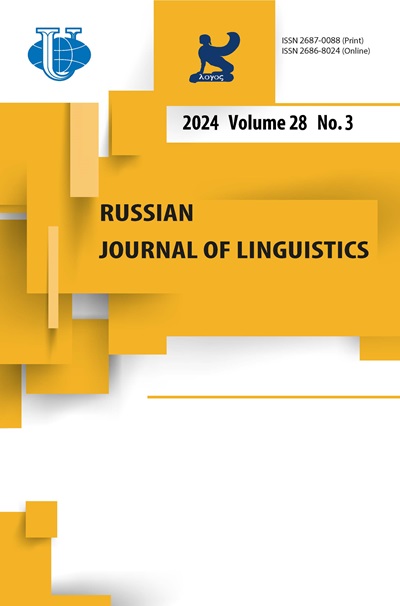Семантическая менажерия: концептуальная семантика этнозоологических категорий
- Авторы: Годдард К.1
-
Учреждения:
- Университет Гриффит
- Выпуск: Том 22, № 3 (2018): Семантические исследования: к юбилею Анны Вежбицкой
- Страницы: 539-559
- Раздел: СЕМАНТИЧЕСКИЕ ИССЛЕДОВАНИЯ: к юбилею Анны Вежбицкой
- URL: https://journals.rudn.ru/linguistics/article/view/19346
- DOI: https://doi.org/10.22363/2312-9182-2018-22-3-539-559
Цитировать
Полный текст
Аннотация
Об авторах
Клифф Годдард
Университет Гриффит
Email: c.goddard@griffith.edu.au
профессор лингвистики в Университете Гриффит (г. Брисбен, Австралия). Он является ведущим разработчиком Естественного Семантического Метаязыка в семантике и теории культурных скриптов в прагматике, также известной как этнопрагматика. Среди его недавних публикаций: сборник статей под его редакцией Minimal English for a Global World (Минимальный английский для глобального мира) (2018, Palgrave), книга в соавторстве с Анной Вежбицкой Words and Meanings: Lexical Semantics Across Domains (Слова и значения: лексическая семантика в разных языках и культурах) (2014, Oxford University Press), второе издание учебника Semantic Analysis (Семантический анализ) (2011, Oxford University Press) и Ten Lectures on Natural Semantic Metalanguage (Десять лекций по Естественному Семантическому Метаязыку) (2018, Brill). 170 Kessels Road, Nathan, Queensland 4111 Australia
Список литературы
- Apresjan, Ju D. (1969). O yazyke dlya opisaniya znachenii slov. Izvestiya Akademii Nauk SSSR, Seriya Literatury i Yazyka, 28, 415-28.
- Apresjan, Ju D. (1992[1974]). Lexical Semantics: User’s Guide to Contemporary Russian Vocabulary. Ann Arbor: Karoma. [Orig. published in 1974 as Leksicheskaya semantika - sinonimicheskie sredstva yazyka (In Russ.), Moskva: Nauka].
- Apresjan, Ju D. (2000). Systematic lexicography. (Windle, K. Trans.). Oxford: Oxford University Press.
- Atran, S. (1990). Cognitive foundations of natural history. Cambridge: Cambridge University Press.
- Berlin, B. (1992). Ethnobiological classification: Principles of categorization of plants and animals in traditional society. Princeton, N.J.: Princeton University Press.
- Bromhead, H. (2011). The bush in Australian English. Australian Journal of Linguistics, 31, 445-471.
- Brown, C. (1979). Folk zoological life forms: Their universality and growth. American Anthropologist,81, 791-817.
- Goddard, C. (ed.). (2008). Cross-linguistic semantics. Amsterdam: John Benjamins.
- Goddard, C. (2009). Cultural scripts. In Senft, G., Östman, J-O, & Verschueren, J. (eds.), Culture and language use. Amsterdam: John Benjamins, 68-80.
- Goddard, C. (2011). Semantic analysis. A practical introduction. Revised 2nd edition. Oxford: Oxford University Press.
- Goddard, C. (2012). Semantic primes, semantic molecules, semantic templates: Key concepts in the NSM approach to lexical typology. Linguistics, 50(3), 711-743.
- Goddard, C. (2016). Semantic molecules and their role in NSM lexical definitions. Cahiers de lexicologie 2016-2, No 109, 13-36.
- Goddard, C. (2017). Furniture, vegetables, weapons: Functional collective superordinates in the English lexicon. In Ye, Z. (ed.) The semantics of nouns. Oxford: Oxford University Press, 246-281.
- Goddard, C. (2018). Minimal English: The science behind it. In Goddard, C. (ed.) Minimal English for a global world: Improved communication using fewer words. London: Palgrave Macmillan, 29-70.
- Goddard, C. & Wierzbicka, A. (eds.) (2002). Meaning and universal grammar: Theory and empirical findings, 2 vols. Amsterdam: John Benjamins.
- Goddard, C. & Wierzbicka, A. (2014). Words and meanings: Lexical semantics across domains, languages and cultures. Oxford: Oxford University Press.
- Haviland, J. B. (1974). A last look at Cook’s Guugu-Yimidhirr wordlist. Oceania, 44 (3), 216-232. [http://pages.ucsd.edu/~jhaviland/Publications/HavilandOceania.pdf]
- Kripke, S. (1977). Naming and necessity. In Davidson, D. & G. Harman (eds.), Semantics of natural language. Dordrecht: Reidel, 253-355.
- Hare, B., Brown, M., Williamson, K. & Tomasello, M. (2002). The domestication of social cognition in dogs. Science 298, 1634-1636.
- Rosch, E. (1977). Human categorization. In Warren, N. (ed.), Advances in cross-cultural psychology.Vol. 1. London: Academic Press, 1-49.
- Rosch, E. (1978). Principles of categorization. In Rosch, E. & B. Lloyd (eds.), Cognition and categorization. Hillsdale, NJ: Lawrence Erlbaum, 27-48.
- Wierzbicka, A. (1985). Lexicography and conceptual analysis. Ann Arbor: Karoma. Wierzbicka, A. (1996). Semantics: Primes and universals. New York: Oxford University Press.
- Wierzbicka, A. (2007). Bodies and their parts: An NSM approach to semantic typology. Language Sciences, 29(1), 14-65.
- Wierzbicka, A. (2009). The theory of the mental lexicon. In Kempgen, S., P. Kosta, B. Tilman & I. Gutschmidt (eds.), The Slavic languages: An international handbook of their structure, their history and their investigation. Berlin: Mouton de Gruyter, 848-863.
- Wierzbicka, A. (2013). Polish zwierzęta ‘animals’ and jabłka ‘apples’: an ethnosemantic inquiry. In Głaz, A., Danaher, D.S. & Łozowski, P. (eds.), The linguistic worldview: Ethnolinguistics, cognition, and culture. London: Versita, 137-159.
- Wierzbicka, A. (2014). Imprisoned in English: The hazards of English as a default language. New York: Oxford University Press.
- Wierzbicka, A. (2015). Language and cultural scripts. In Sharifian, F. (ed.), The Routledge handbook of language and culture. Routledge, 339-56.
- Ye, Z. (ed.). (2017). The semantics of nouns. Oxford: Oxford University Press.

















